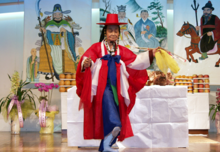User:Bevthewise/sandbox
 |
| Part of a series on the |
| Culture of Korea |
|---|
| Society |
| Arts and literature |
| Other |
| Symbols |
|
Religion in Korea. Throughout the ages, there have been various popular religious traditions practiced on the Korean peninsula. The oldest indigenous religion of Korea is the Korean folk religion (a version of Shamanism), which has been passed down from prehistory to the present.[1] Buddhism was introduced to Korea from China during the Three Kingdoms era in the 4th century, and the religion pervaded the culture until the Joseon Dynasty, when Confucianism was established as the state philosophy.[2] During the Late Joseon Dynasty, in the 19th century, Christianity began to gain a foothold in Korea.[3] While both Christianity and Buddhism would play important roles in the resistance to the Japanese occupation of Korea in the first half of the 20th century,[4] only about 4% of Koreans were members of a religious organization in 1940.[5]
Since the division of Korea into two sovereign states in 1945—North Korea and South Korea—religious life in the two countries has diverged, shaped by different political structures. Religion in South Korea has been characterized by a rise of Christianity and a revival of Buddhism, though the majority of South Koreans have no religious affiliation or follow folk religions.[6][7] Religion in North Korea is characterized by state atheism in which freedom of religion is nonexistent. Juche ideology, which promotes the North Korean cult of personality, is regarded by experts as a kind of national religion.[8]
Korean Shamanism (Korean Folk Religion)
[edit]
Shamanism or Folk Religion (Korean: 무속신앙, 무속, or 민간신앙; Hanja: 巫敎, 巫俗, or 民間信仰; museokshinang, museok, or minganshinang) is the oldest religious tradition in Korea, dating back as far as Old Joseon.[9] (cite choson) Given it's ancient origins, while Shamanism is still practiced, it considered rather heretical and superstitious today. Shamans are typically women who are called mudang (Korean: 무당; Hanja: 巫―).
There are many myths and legends surrounding Korean Shamanism, but today, Koreans mostly go to shamans to get advice, interpret the importence of dates and omens, to determine compatability in a couple, or to get a bujeok (Korean: 부적; Hanja: 符籍), or talisman, to ward away evil spirits.[10]
That said, Shamans may preform gut (a ritualistic dance and song as a prayer to gods or ancestors, or a purification ritual. (cite)
Korean Buddhism
[edit]***There will be a medium sized description here and I will be using the source I found.****
History (Hwarang)
[edit]****more text will go here******
Korean Confucianism
[edit]***stuff***
Korean Christianity
[edit]****here***
References
[edit]- ^ Yu (2012), p. 41.
- ^ Encyclopaedia Britannica (2008), p. 162.
- ^ Kim (2012).
- ^ Yu (2012), p. xv.
- ^ Baker, Don (2013). "Korea's Path of Secularisation". In Ghosh, Ranjan (ed.). Making Sense of the Secular: Critical Perspectives from Europe to Asia. Routledge. pp. 182–193. ISBN 978-1136277214.
- ^ Baker, Donald L. (2008). Korean Spirituality. University of Hawaii Press. pp. 3–4. ISBN 978-0824832339.
- ^ "성, 연령 및 종교별 인구 - 시군구" [Population by Gender, Age, and Religion - City/Country]. Korean Statistical Information Service (in Korean). 2015. Retrieved 2018-03-17.
- ^ Annual Report of the United States Commission on International Religious Freedom (PDF). United States Commission on International Religious Freedom. 2017. p. 56.
- ^ "무교". terms.naver.com (in Korean). Retrieved 2021-03-25.
- ^ Eng, Karen Frances (2018-03-08). "In 21st-century Korea, shamanism is not only thriving — but evolving". Medium. Retrieved 2021-03-26.
Sources
[edit]- Encyclopaedia Britannica (2008). Encyclopedia of World Religions. Encyclopaedia Britannica Inc. ISBN 978-1593394912.
{{cite book}}: CS1 maint: ref duplicates default (link) - Kim, Sebastian C. H.; Kim, Kirsteen (2014). A History of Korean Christianity. Cambridge: Cambridge University Press. ISBN 978-1316123140.
- Yu, Chai-Shin (2012). The New History of Korean Civilization. iUniverse. ISBN 978-1462055593.

